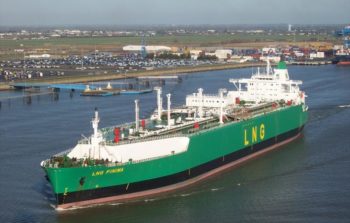
The U.S. Energy Information Administration (EIA) said on Monday that global liquefied natural gas (LNG) trade grew by 10 percent last year due primarily to growing liquefaction capacity in Australia and the United States.
LNG trade reached 38.2 billion cubic feet per day (bcfd) in 2017, up 3.5 bcfd from 2016 and the largest annual volume increase on record, the EIA said, citing the Annual Report on LNG trade by the International Association of Liquefied Natural Gas Importers (GIIGNL).
New liquefaction export capacity commissioned in Australia, the United States and Russia, collectively added 3.4 bcfd of liquefaction capacity. Russia’s new capacity only came online in December.
The world’s first floating liquefaction plant, Malaysia’s 0.2-bcfd PFLNG Satu, was also commissioned in 2017, EIA said.
Including additions in the United States and Australia, liquefaction projects currently under construction are projected to increase global capacity by 13.5 bcfd by 2022, EIA said.
One billion cubic feet of natural gas is enough to fuel about five million U.S. homes for a day.
In 2017, there were 19 LNG exporting countries and 40 importing countries.
Besides Australia and the United States, EIA said several other countries also increased LNG exports in 2017, including Angola, Nigeria, Malaysia, Algeria, Russia and Brunei, which together added another 1.4 bcfd of exports.
That more than offset a combined decline of 0.6 bcfd in exports from Qatar, Indonesia, Norway, Peru, the United Arab Emirates and Trinidad, the EIA said.
Asian countries led growth in global LNG imports, accounting for 74 percent, or 2.6 bcfd, of the increase in 2017.
Japan remained the largest LNG importer at 11.0 bcfd in 2017.
China had the largest growth in LNG imports globally at 1.5 bcfd and became the world’s second-largest LNG importer at 5.2 bcfd in 2017, surpassing South Korea.
LNG imports also increased in South Korea, Pakistan, Taiwan, and Thailand, which collectively added 1.0 bcfd.
Europe increased its LNG imports by 1.4 bcfd, primarily in Spain, Italy, Portugal, France, and Turkey.
In North America, Mexico’s LNG imports increased by 17 percent as the country continued to rely on LNG supplies amid declining domestic production and construction delays in infrastructure connecting the Mexican domestic grid to gas pipeline exports from the United States.
Agency Report